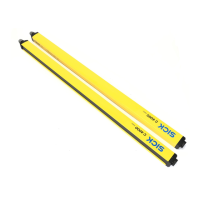
Do you have a question about the SICK C4000 Select and is the answer not in the manual?
| Type | Safety Light Curtain |
|---|---|
| Safety Integrity Level | SIL3 |
| Performance Level | PL e |
| Enclosure Rating | IP65 |
| Category | Category 4 |
| Light Source | Infrared LED |
| Operating Voltage | 24 V DC |
| Protection Class | III |
| Resolution | 14 mm, 30 mm |
| Protective Field Height | 300 mm to 1800 mm |
| Operating Range | 0.5m to 9m |
| Supply Voltage | 24 V DC |
| Operating Temperature | -30 °C to +55 °C |
| Synchronization | Optical, via cable |
| Beam Divergence | 2.5° |
| Housing Material | Aluminum |
| Ambient Temperature Range | -25 °C ... +55 °C |
| Output Type | PNP |
Reference list of technical terms used in the manual.
Explains symbols for warnings, notes, and device parts.
Defines requirements for personnel installing and operating the device.
Lists certified applications and technical capabilities of the light curtain.
Outlines crucial safety procedures and regulations to follow.
Highlights key functionalities like laser alignment and DIP switch configuration.
Describes LED and 7-segment display meanings for operational status.
Details enabling extended I/O for cascading and system integration.
Explains how to prevent optical interference between adjacent systems.
Covers selectable scanning ranges and their impact on protective field width.
Describes functionality allowing fixed-size objects in the protective field.
Crucial for ensuring machine safety and preventing access to hazards.
Provides guidance on physically attaching the sender and receiver.
Explains how to use the integrated laser for precise optical alignment.
Details pin assignments for basic system connection.
Describes connections for cascading and I/O.
Covers alternative connection options for extended I/O.
Step-by-step guide for achieving correct optical alignment.
Outlines essential tests for confirming safety requirements.
Describes procedures for routine safety verification.
Provides immediate actions for malfunctions and system lock-outs.
Explains LED indicators for troubleshooting.
Details error codes shown on the display for diagnosis.
Comprehensive technical parameters and certifications of the device.
Critical for safety distance calculations and system performance.
Part numbers for standalone or last segment units.
Lists available mounting brackets, cables, and other related parts.
A guide for OEMs to ensure correct installation and compliance.